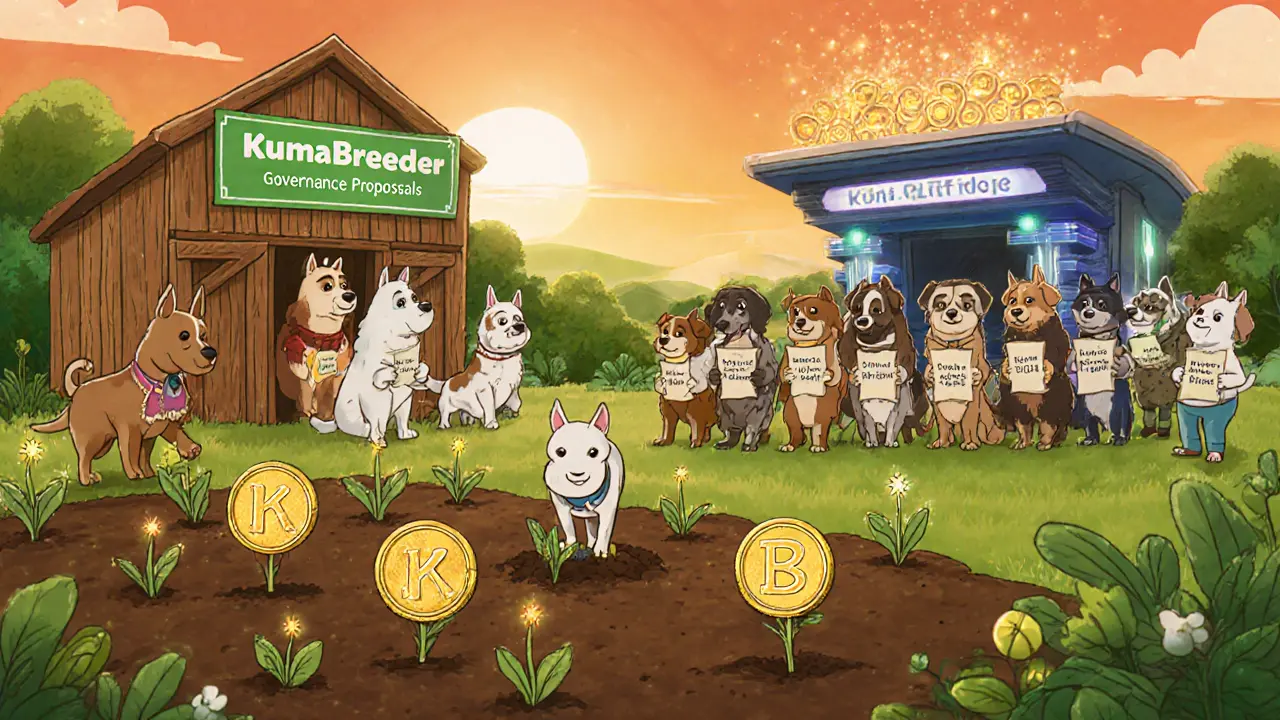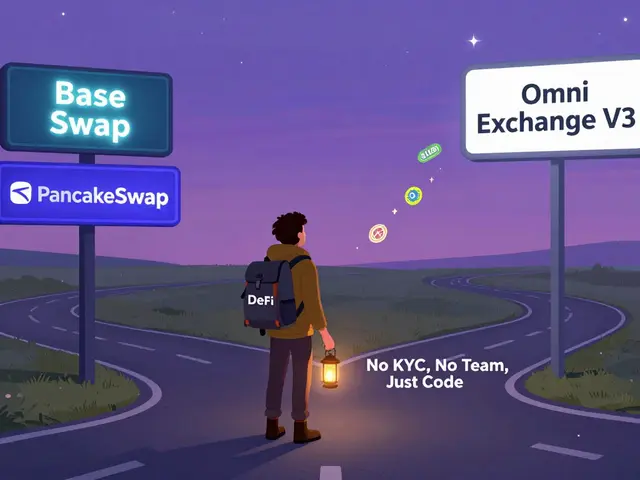Kuma Inu Airdrop Checker
Enter details about a claimed Kuma Inu airdrop to verify its legitimacy.
Enter details and click "Verify Airdrop" to see results.
When talking about the buzz around meme‑tokens, Kuma Inu is often mentioned as the next possible airdrop candidate. Kuma Inu (tickerKUMA) is a community‑driven meme token that has added DeFi features such as yield farming and a decentralized governance model. The token’s current market price hovers around $0.0000000032USD and, as of the latest snapshot, it shows virtually no 24‑hour trading volume.
Why the Confusion Exists
The biggest source of misinformation is the similarity of names. A separate project, simply called Kuma, rebranded from IDEX on March242025 and now lives inside the Berachain ecosystem. Kuma (the platform) runs a hybrid decentralized exchange with on‑chain settlement for Ethereum assets and has launched a reward program that distributes BGT (Berachain Gas Token) to active traders. Because both projects use the word “Kuma,” many social‑media posts mix their announcements, creating the illusion of a joint airdrop.
What Kuma Inu Actually Is
Kuma Inu’s core offering is the Kuma Breeder protocol. This yield‑farming system lets users lock up KUMA tokens to earn dKuma - a derivative token that represents a share of the farming pool. The protocol’s design emphasizes “fair distribution”, meaning rewards are spread across all participants rather than concentrated in a few large holders.
Governance is handled via a fully Decentralized Autonomous Governance (DAG) model. Token holders can submit proposals on marketing spend, code upgrades, or community events, and votes are tallied automatically on‑chain. However, the governance documentation does not list any proposal related to token airdrops, and no snapshot dates or eligibility criteria have ever been published.
What the Rebranded Kuma Platform Does
Unlike Kuma Inu, the Kuma exchange (formerly IDEX) focuses on trading infrastructure. It combines a centralized order‑matching engine with on‑chain settlement, aiming for the speed of a CEX and the security of a DEX. After its March2025 rebrand, Kuma announced a points‑based reward system that begins on April12025. Users who trade perpetual futures on the platform earn points that can be redeemed for BGT tokens. This is the first phase of Kuma’s integration with the Berachain Proof‑of‑Liquidity consensus, and it is fully documented on the platform’s official site.
Importantly, the Kuma platform has *not* pledged to distribute any KUMA token. The only confirmed distribution is the BGT reward, and the airdrop status for a potential KUMA token remains listed as “unconfirmed” on airdrops.io.

2025 Airdrop Landscape: A Quick Look
2025 has seen a resurgence of legitimate airdrops, but the bar for credibility has risen. Projects like Binance Alpha’s Sidekick airdrop (August82025) and Yei Finance’s CLO token distribution (registration until September302025) provide clear timelines, registration steps, and on‑chain claim mechanisms. These examples underline two essential elements: a transparent eligibility snapshot and a verifiable smart‑contract address.
- Clear snapshot date - the block height at which holders are recorded.
- Defined eligibility - usually a minimum balance or activity requirement.
- Public claim contract - a verified address where users can claim tokens.
When an airdrop claim lacks any of these components, the risk of scams spikes dramatically.
Current Status of the Kuma Inu Airdrop
Despite the hype on various forums, there is **no official announcement** from the Kuma Inu team about an airdrop. The project’s website and official social channels have not posted a roadmap item related to token distribution beyond the existing yield‑farming program. No smart‑contract address for a KUMA airdrop has been posted, and no snapshot block has been cited.
Some community members have circulated unofficial “airdrop calculators” that claim users can claim up to 500KUMA based on past trading volume. These tools are not backed by the project’s GitHub repository, and they often request private keys or wallet passwords - a classic red flag.
Comparison: Kuma Inu vs. Kuma (Platform) Rewards
| Feature | Kuma Inu (KUMA) | Kuma Platform (Berachain) |
|---|---|---|
| Primary token | KUMA | BGT (Berachain Gas Token) |
| Officially confirmed airdrop? | No | No (reward program confirmed) |
| Reward mechanism | Yield farming via Kuma Breeder | Points for perpetual futures trading |
| Governance involvement | Token holders can vote on proposals (no airdrop proposals yet) | Governance via Berachain DAO, not tied to airdrops |
| Current market activity | ~$0 price, 024‑h volume | Active trading, measurable volume on Kuma DEX |

How to Verify Any Kuma‑Related Airdrop Claim
- Check the official project website. Look for a dedicated “Airdrop” or “Rewards” page that lists a snapshot block, eligibility criteria, and a claim contract address.
- Cross‑reference the information with the project’s GitHub repository. A legitimate airdrop will have the smart‑contract source code publicly available.
- Search for announcements on reputable platforms (CoinMarketCap, CoinGecko, or official Twitter verified accounts). These sites usually flag scam attempts.
- Avoid any service that asks for private keys, seed phrases, or a payment to “unlock” the airdrop. Real airdrops are free.
- Use blockchain explorers (Etherscan, BscScan, etc.) to verify that the claim contract has indeed transferred tokens to users.
Following this checklist will keep you from losing funds to phishing sites that masquerade as a “Kuma Inu airdrop”.
Risks and Cautions Specific to Kuma Inu
Even if a future airdrop were announced, investors should weigh the token’s underlying fundamentals. The price’s current level ($0.0000000032USD) reflects minimal liquidity, and the 24‑hour volume is effectively zero. Low liquidity can cause slippage and make it hard to sell any airdropped tokens. Additionally, meme tokens often face regulatory scrutiny, which could result in delistings or even a forced token burn.
From a technical standpoint, Kuma Inu’s governance contracts have not disclosed any “airdrop proposal” functions. Without a defined voting threshold or a clear snapshot mechanism, implementing a fair airdrop would be challenging for the community.
Key Takeaways
- There is **no verified KUMA airdrop** from the Kuma Inu team as of October2025.
- The confusion stems from a separate project, Kuma (formerly IDEX), which offers BGT rewards but does not distribute KUMA.
- Legitimate airdrops in 2025 include clear snapshot dates, public claim contracts, and no requests for private keys.
- Kuma Inu’s market activity is extremely low, making any potential airdrop less attractive from a liquidity perspective.
- Use the verification checklist above before engaging with any claim that mentions a Kuma Inu airdrop.
Frequently Asked Questions
Is there an official Kuma Inu airdrop scheduled for 2025?
No. The Kuma Inu team has not posted any official airdrop announcement, snapshot date, or claim contract for 2025. All circulating rumors lack verification.
How does the Kuma platform’s reward system differ from an airdrop?
Kuma’s reward program grants BGT tokens based on trading activity (points earned from perpetual futures). An airdrop typically distributes tokens for free based on a snapshot of holdings, without requiring any trading volume.
Can I claim KUMA tokens from the Kuma Breeder yield farm?
You can earn dKuma by staking KUMA in the Kuma Breeder protocol, but this is a farming reward, not an airdrop. Claims are made through the protocol’s UI, not via a separate airdrop contract.
What red flags should I watch for in a fake Kuma Inu airdrop?
Requests for private keys or seed phrases, promises of guaranteed profits, lack of an official source, and the need to pay a fee to claim are all classic signs of a scam.
Will a future airdrop make KUMA a worthwhile investment?
An airdrop could boost short‑term demand, but long‑term value still depends on liquidity, utility, and community activity. Investors should evaluate those fundamentals instead of counting on a potential airdrop.







Stephanie Alya
October 10, 2025 AT 20:39So let me get this straight - people are giving away free money… that doesn’t exist? 🤡
Manish Gupta
October 11, 2025 AT 17:21I saw a post on Telegram saying KUMA airdrop is live… I almost sent my seed phrase. Thank god I checked here first. 😅
Rampraveen Rani
October 12, 2025 AT 03:45Bro the Kuma Inu devs are just chilling on the beach while the whole crypto world is panicking over a ghost token. Meanwhile, Kuma (Berachain) is actually building something real. Stop chasing ghosts 🐶
olufunmi ajibade
October 12, 2025 AT 04:27Why do people keep falling for this? You don’t need to be a genius to know if there’s no snapshot, no contract, no announcement - it’s a scam. And yet here we are, 2025, and people still copy-paste ‘500KUMA AIRDROP’ into their wallets like it’s a lottery ticket. Wake up. This isn’t 2021. The bar is higher now. If you’re not checking Etherscan before clicking, you deserve to lose everything.
Sarah Hannay
October 12, 2025 AT 11:49It’s deeply concerning how easily misinformation propagates in decentralized spaces. The absence of verifiable on-chain data - snapshot, eligibility, claim mechanism - is not merely an oversight; it is a structural red flag that should trigger immediate skepticism. The fact that users are still engaging with unverified tools that request private keys speaks to a systemic failure in financial literacy. We must prioritize education over speculation.
Abby Gonzales Hoffman
October 13, 2025 AT 09:10Look - I get it. Meme coins are fun. But if your ‘investment strategy’ is hoping a token with $0 volume and no team announcement is gonna drop 1000x… you’re not investing, you’re gambling with your life savings. The Kuma Inu thing? Total ghost town. The Kuma/Berachain thing? Real trading, real points, real BGT. Don’t mix them up. And if someone DMs you a link to ‘claim KUMA’ - block them. Then report them. Then go drink water. You deserve better than this chaos.
Prabhleen Bhatti
October 13, 2025 AT 17:08As someone who’s been in crypto since 2017, I’ve seen this movie before - the name-squatting, the bot-driven hype, the fake calculators, the ‘limited-time’ urgency. Kuma Inu? Zero liquidity, zero volume, zero governance proposals for an airdrop. Meanwhile, Kuma (Berachain) is integrating with PoL, launching real incentives, and documenting everything on-chain. The confusion isn’t accidental - it’s engineered. And yes, the $0.0000000032 price? That’s not a bargain - it’s a tombstone. Don’t let FOMO turn your wallet into a graveyard. Stay sharp. 🌸
Shruti rana Rana
October 13, 2025 AT 18:04Oh my goodness, this is such an important post! 🙏 I live in India and I’ve seen so many friends lose money on these fake airdrops - they think ‘Kuma’ sounds cute and they just click! Please, everyone, share this everywhere! Even on WhatsApp groups! 📲❤️ The Kuma Inu scam is everywhere - and we must protect our communities! 🌏✨
Richard Williams
October 14, 2025 AT 08:51Big shoutout to the OP for laying this out so clearly. This is exactly the kind of post that saves people from getting rug-pulled. I’ve been helping my cousin navigate crypto for the last year - he was about to send his ETH to a ‘Kuma Inu claim portal’. I sent him this thread. He’s now safe. Thank you. Keep doing this work.
ashish ramani
October 14, 2025 AT 17:50Just want to say: if you're asking for private keys, you're not a project. You're a predator. End of story.
Cyndy Mcquiston
October 15, 2025 AT 10:18Why are we even talking about this? It’s a joke. The whole thing is a joke. Americans think meme coins are investments. India thinks they’re lottery tickets. Nigeria thinks they’re remittances. It’s all the same trash. Just move on.
Elizabeth Mitchell
October 16, 2025 AT 00:06Interesting breakdown. I didn’t realize Kuma (Berachain) and Kuma Inu were separate. I thought they were the same. Guess I fell for the name thing too. Thanks for clearing that up.
Chris Houser
October 16, 2025 AT 01:01Man, I’ve seen this pattern in Africa too. People get excited about ‘free crypto’ and ignore the basics. Kuma Inu? Zero volume, zero team updates, zero transparency. Meanwhile, real projects like Berachain are building infrastructure. The difference? One is a party. The other is a company. Don’t confuse the two. And if you’re new - read the docs. Don’t just follow influencers.
Natasha Nelson
October 16, 2025 AT 12:43Wow. This is… actually really helpful. I didn’t know the difference between Kuma and Kuma Inu. I thought they were one. I’m so glad I read this. I almost clicked a link that said ‘claim your 500,000 KUMA now!!’ - and I didn’t even know what KUMA was. Thank you. I’m saving this.
William Burns
October 17, 2025 AT 11:48It is rather regrettable that the intellectual rigor required to discern legitimate tokenomics from performative meme-driven speculation has become a prerequisite for basic participation in the digital asset ecosystem. One must now possess not only technical literacy but also epistemological discernment - a burden that, frankly, ought not be borne by the average participant. The proliferation of homonyms such as Kuma and Kuma Inu is not merely an oversight; it is a systemic degradation of semantic integrity within decentralized finance. One can only hope that regulatory bodies will intervene before the next generation is lost to this semantic farce.
Richard Williams
October 18, 2025 AT 01:53Hey @673 - I get you’re trying to sound smart, but most people just want to know if they’ll get scammed. You just turned a lifesaving post into a philosophy essay. Maybe next time, lead with the checklist?